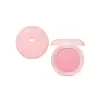What's inside
What's inside
 Key Ingredients
Key Ingredients

 Benefits
Benefits

 Concerns
Concerns

 Ingredients Side-by-side
Ingredients Side-by-side

Mica
Cosmetic ColorantDiphenylsiloxy Phenyl Trimethicone
Skin ConditioningDimethicone
EmollientDiisostearyl Malate
EmollientHydrogenated Poly(C6-14 Olefin)
EmollientCI 77891
Cosmetic ColorantLauroyl Lysine
Skin ConditioningSilica
AbrasiveDimethicone/Vinyl Dimethicone Crosspolymer
Skin ConditioningMagnesium Myristate
Ethylhexylglycerin
Skin ConditioningCI 73360
Cosmetic ColorantAluminum Hydroxide
EmollientCI 77492
Cosmetic ColorantCaprylyl Glycol
EmollientMethicone
EmollientCI 77007
Cosmetic ColorantCI 77491
Cosmetic ColorantCI 77499
Cosmetic ColorantTocopherol
AntioxidantMica, Diphenylsiloxy Phenyl Trimethicone, Dimethicone, Diisostearyl Malate, Hydrogenated Poly(C6-14 Olefin), CI 77891, Lauroyl Lysine, Silica, Dimethicone/Vinyl Dimethicone Crosspolymer, Magnesium Myristate, Ethylhexylglycerin, CI 73360, Aluminum Hydroxide, CI 77492, Caprylyl Glycol, Methicone, CI 77007, CI 77491, CI 77499, Tocopherol
Polyglyceryl-2 Triisostearate
EmulsifyingTriethylhexanoin
MaskingMagnesium/Potassium/Silicon/Fluoride/Hydroxide/Oxide
Stearic Acid
CleansingZinc Myristate
Diisostearyl Malate
EmollientHdi/Trimethylol Hexyllactone Crosspolymer
Pentylene Glycol
Skin ConditioningBis-Diglyceryl Polyacyladipate-2
EmollientPhenoxyethanol
PreservativeHydrogen Dimethicone
Methylparaben
PreservativeSilica
AbrasiveTocopherol
AntioxidantRosa Canina Fruit Oil
EmollientSqualane
EmollientSimmondsia Chinensis Seed Oil
EmollientTalc
AbrasiveMica
Cosmetic ColorantSynthetic Fluorphlogopite
Titanium Dioxide
Cosmetic ColorantCI 77492
Cosmetic ColorantCI 45380
Cosmetic ColorantCI 15985
Cosmetic ColorantTin Oxide
AbrasiveAluminum Hydroxide
EmollientPolyglyceryl-2 Triisostearate, Triethylhexanoin, Magnesium/Potassium/Silicon/Fluoride/Hydroxide/Oxide, Stearic Acid, Zinc Myristate, Diisostearyl Malate, Hdi/Trimethylol Hexyllactone Crosspolymer, Pentylene Glycol, Bis-Diglyceryl Polyacyladipate-2, Phenoxyethanol, Hydrogen Dimethicone, Methylparaben, Silica, Tocopherol, Rosa Canina Fruit Oil, Squalane, Simmondsia Chinensis Seed Oil, Talc, Mica, Synthetic Fluorphlogopite, Titanium Dioxide, CI 77492, CI 45380, CI 15985, Tin Oxide, Aluminum Hydroxide
Ingredients Explained
These ingredients are found in both products.
Ingredients higher up in an ingredient list are typically present in a larger amount.
Aluminum Hydroxide is a form of aluminum. It can be naturally found in nature as the mineral gibbsite. In cosmetics, Aluminum Hydroxide is used as a colorant, pH adjuster, and absorbent.
As a colorant, Aluminum Hydroxide may add opacity, or reduce the transparency. Aluminum hydroxide is contains both basic and acidic properties.
According to manufacturers, this ingredient is an emollient and humectant. This means it helps hydrate the skin.
In medicine, this ingredient is used to help relieve heartburn and help heal ulcers.
There is currently no credible scientific evidence linking aluminum hydroxide in cosmetics to increased cancer risk.
Major health organizations allow the use of aluminum hydroxide in personal care products and have not flagged it as a carcinogenic risk at typical usage levels.
Learn more about Aluminum HydroxideCi 77492 is also hydrated iron III oxide. It's sole purpose is to give a yellow hue to products.
Iron III oxides are classified as inorganic chemicals for coloring.
Synthetically created Ci 77492 is considered safer than those naturally found. This is because the synthetically created version may contain less impurities. Iron oxides are generally non-toxic and non-allergenic.
Learn more about CI 77492Diisostearyl Malate is an emollient and most often used in lip products. It comes from isostearyl alcohol, a fatty acid, and malic acid, an AHA.
As an emollient, Diisostearyl Malate helps create a thin film on your skin to trap moisture in. This helps keep your skin soft and smooth.
Mica is a naturally occurring mineral used to add shimmer and color in cosmetics. It can also help improve the texture of a product or give it an opaque, white/silver color.
Serecite is the name for very fine but ragged grains of mica.
This ingredient is often coated with metal oxides like titanium dioxide. Trace amounts of heavy metals may be found in mica, but these metals are not harmful in our personal products.
Mica has been used since prehistoric times throughout the world. Ancient Egyptian, Indian, Greek, Roman, Aztec, and Chinese civilizations have used mica.
Learn more about MicaSilica, also known as silicon dioxide, is a naturally occurring mineral. It is used as a fine, spherical, and porous powder in cosmetics.
Though it has exfoliant properties, the function of silica varies depending on the product.
The unique structure of silica enhances the spreadability and adds smoothness, making it a great texture enhancer.
It is also used as an active carrier, emulsifier, and mattifier due to its ability to absorb excess oil.
In some products, tiny microneedles called spicules are made from silica or hydrolyzed sponge. When you rub them in, they lightly polish away dead skin layers and enhance the penetration of active ingredients.
Learn more about SilicaTocopherol (also known as Vitamin E) is a common antioxidant used to help protect the skin from free-radicals and strengthen the skin barrier. It's also fat soluble - this means our skin is great at absorbing it.
Vitamin E also helps keep your natural skin lipids healthy. Your lipid skin barrier naturally consists of lipids, ceramides, and fatty acids. Vitamin E offers extra protection for your skin’s lipid barrier, keeping your skin healthy and nourished.
Another benefit is a bit of UV protection. Vitamin E helps reduce the damage caused by UVB rays. (It should not replace your sunscreen). Combining it with Vitamin C can decrease sunburned cells and hyperpigmentation after UV exposure.
You might have noticed Vitamin E + C often paired together. This is because it is great at stabilizing Vitamin C. Using the two together helps increase the effectiveness of both ingredients.
There are often claims that Vitamin E can reduce/prevent scarring, but these claims haven't been confirmed by scientific research.
Learn more about Tocopherol